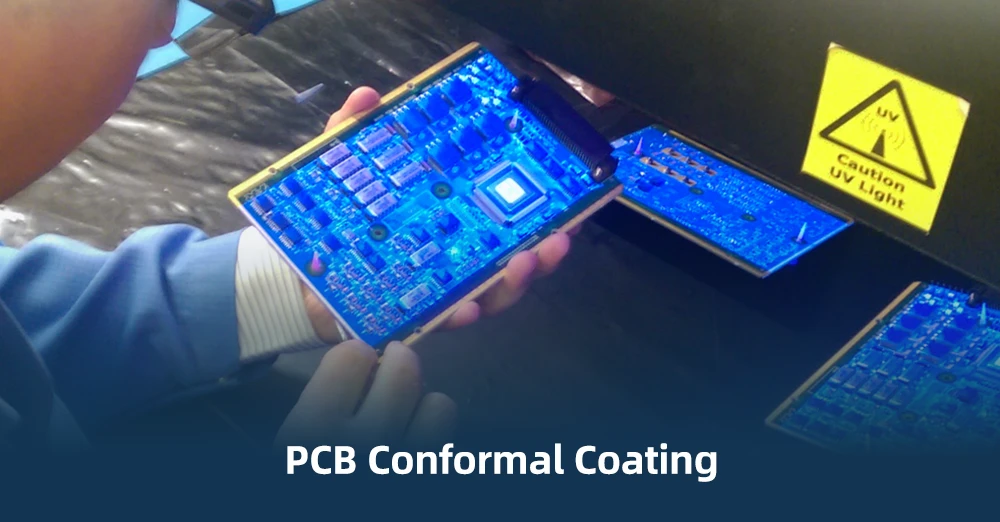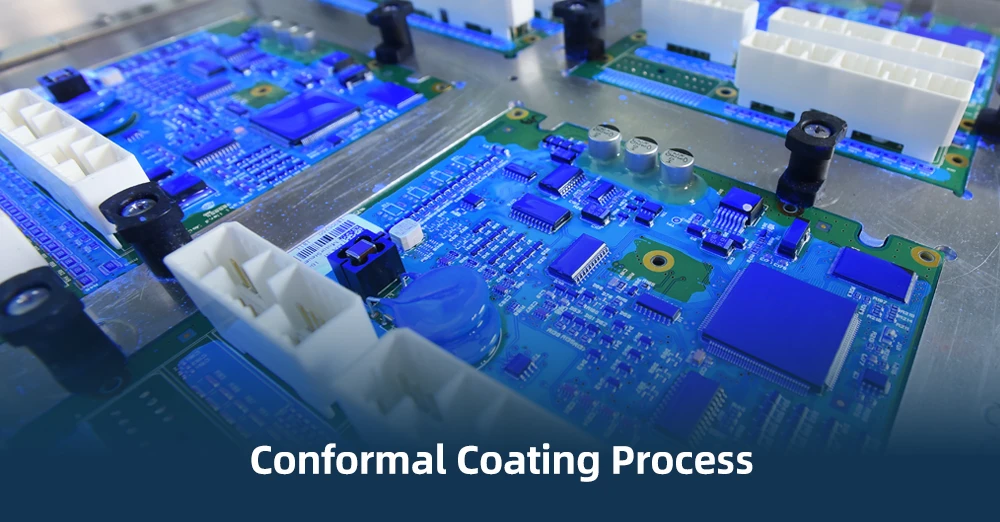Welcome aboard, dear reader, to the riveting world of conformal coating. You might be thinking, “riveting and conformal coating” in the same sentence. Well, allow us to sway your opinion.
You see, conformal coating enhances the reliability and performance of a wide array of products you use daily. From that smartphone you’re possibly holding right now to the satellite orbiting Earth dutifully, this stuff is everywhere. So, read on as we embark on this journey to unveil the power locked within the conformal coating.
What Is Conformal Coating?
So, you’re probably wondering, “What on earth is this ‘conformal coating’?” Let’s break it down, shall we? To put it simply, a conformal coating is a thin, protective layer that “conforms” to the contours of a printed circuit board (PCB).

Water damage? Dust? Chemical corrosion? With a conformal coating, your PCB can laugh in the face of these threats, ensuring the longevity and performance of your products. So, in the epic battle of electronics versus environment, conformal coating is the secret weapon you never knew was needed.

Is Conformal Coating Waterproof?
Here’s what to consider in regards to whether or not conformal coating is waterproof:
- Material type – there are different types of materials used in conformal coating, including urethanes, silicones, acrylics, and even epoxies. All these materials have distinct levels of water resistance. The silicone material is particularly great for conformal coating because of its impeccable water resistance.
- Application procedure – the method used in the application can affect the effectiveness of the conformal coating. Adequate thickness and proper application will ensure that the needed level of protection is achieved.
- Thickness – the thickness of the conformal coating can dictate its water resistance capabilities. Thicker coatings are ideal for better water resistance.
- Sealing components – to boost water resistance, extra measures such as encapsulation and potting can be taken to protect critical components.
- Environmental conditions – exposure to immersion, splashes, and high humidity will dictate whether or not the conformal coating is made waterproof.
Does PCB Need Conformal Coating?

Whether or not a printed circuit board needs conformal coating is dependent on the following factors:
- Environmental exposure – exposure to harsh environmental factors such as chemicals, dust, moisture, extreme temperatures, and vibrations will require the use of conformal coating in a PCB. The coating will cut down on electrical failures, corrosion, and other environmental threats.
- Application – certain applications need the use of conformal coating, such as outdoor electronics, the aviation industry, the industrial sector, and the automotive industry.
- Reliability needs – a conformal coating is necessary in scenarios where there’s a need for high reliability. It helps to prevent dendrite formation and tin whisker growth, among many other issues. Such problems would typically affect the PCB’s performance.
- Corrosion prevention – a conformal coating is equally necessary in preventing corrosion. This is crucial for corrosive and humid environments.
- Cleaning and maintenance – conformal coatings make it easier to clean and maintain PCBs through the presence of protective barriers against contaminants.
- Cost and complexity – in some cost-dependent applications, which are typically simple, adding a conformal coating may be unnecessary.
- Controlled environments – in surroundings where the printed circuit board doesn’t face harsh environmental conditions, there may be no need for conformal coating.
What Is the Purpose of Conformal Coating on PCB?
Here are some of the crucial roles that a conformal coating plays on any PCB:
- Increases reliability.
- Makes maintenance easier.
- UV stability.
- Provided electrical insulation.
- Offers mechanical protection.
- Provides thermal and temperature protection.
- Offers chemical resistance.
- Prevents corrosion.
- Offers environmental protection.
What Are the Disadvantages of Conformal Coating?
Conformal coatings have plenty of advantages and uses. However, they also have a few drawbacks, including the following:
- There’s limited accessibility for modifications and repairs.
- Heat dissipation challenges.
- It has an impact on high-frequency signals.
- Application challenges.
- The cost of application is high.
- Compatibility challenges.
- Makes inspection difficult.
- Challenges in rework and removal.
- Humidity trapping due to improper installation.
- Environmental impact in terms of disposal and recycling.
What Is a Conformal Coating for PCB Standards?
Standards and specifications for conformal coating on PCBs provide guidelines for their selection, application, and performance. Developed by organizations, these standards ensure consistency and quality in the coating process. Commonly referenced standards include the following:
- IPC standards such as IPC-CC-830 and IPC-A-610.
- MIL-STD standards such as MIL-I-46058C and MIL-PRF-55342G.
- IEC standards such as IEC 61086.
- UL standards such as UL 746E.
- ASTM standards such as ASTM D4060.
What Is the Conformal Coating Process?

Here are the steps involved in the conformal coating process:
1. Cleaning and preparation – cleaning the PCB is necessary to get rid of any contaminants or residues.
2. Masking – certain PCB parts are masked off to prevent the conformal coating from covering them.
3. Coating material selection – the specific needs of the application will dictate the type of conformal coating you choose.
4. Application methods – there are different application methods for conformal coating, including brushing/manual application, dipping, and spraying.
5. Drying or curing – room temperature curing or heat curing is used.
6. Inspection – visual inspection is necessary after curing to ensure there’s uniform coverage, proper adhesion, and an absence of any defects. For large-scale production, automated inspection units are employed.
7. Testing – tests are conducted to ensure that everything is working optimally. Some of the tests that can be conducted include environmental testing, electrical testing, and adhesion testing.
8. Removal of masks – in case masking was used, masking materials are removed so that the uncoated areas are exposed.
Conformal Coating Types
The following are examples of conformal coating types:
- Fluoropolymer Conformal Coatings.
- Polyurethane Conformal Coatings.
- Parylene Coatings.
- Epoxy Conformal Coatings.
- Silicone Conformal Coatings.
- Urethane Conformal Coatings.
- Acrylic Conformal Coatings.
Final Thoughts
In conclusion, the magic wand that bestows longevity and resilience on your electronic devices is nothing but a heroic layer of conformal coating. It guards your devices against the harshest of weather, the most unforgiving environments, and the most unpredictable accidents. So, when your gadget survives a coffee spill or continues to work flawlessly on a chilly winter night, tip your hat to conformal coating.
And where should you turn for this electronic reliability? Look no further than IBE. At IBE, we don’t just supply conformal coating; we live and breathe it. Remember, a layer of conformal coating a day keeps the device doctor away!
Conformal coating is a protective, breathable coating of thin polymeric film applied to printed circuit boards (PCBs). Conformal coatings are typically applied at 25–250 μm to the electronic circuitry and protect against moisture and other harsher conditions.
Here are some of the crucial roles that a conformal coating plays on any PCB:
- Increases reliability.
- Makes maintenance easier.
UV stability. - Provided electrical insulation.
Offers mechanical protection. - Provides thermal and temperature protection.
- Offers chemical resistance.
Prevents corrosion. - Offers environmental protection.
Here are the steps involved in the conformal coating process:
1. Cleaning and preparation
2. Masking
3. Coating material selection
4. Application methods
5. Drying or curing
6. Inspection
7. Testing
8. Removal of masks










